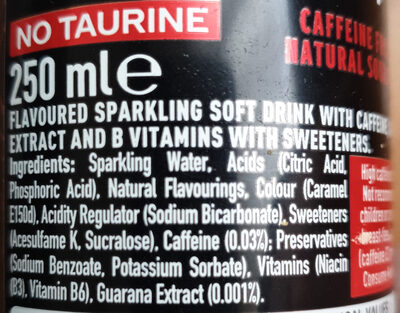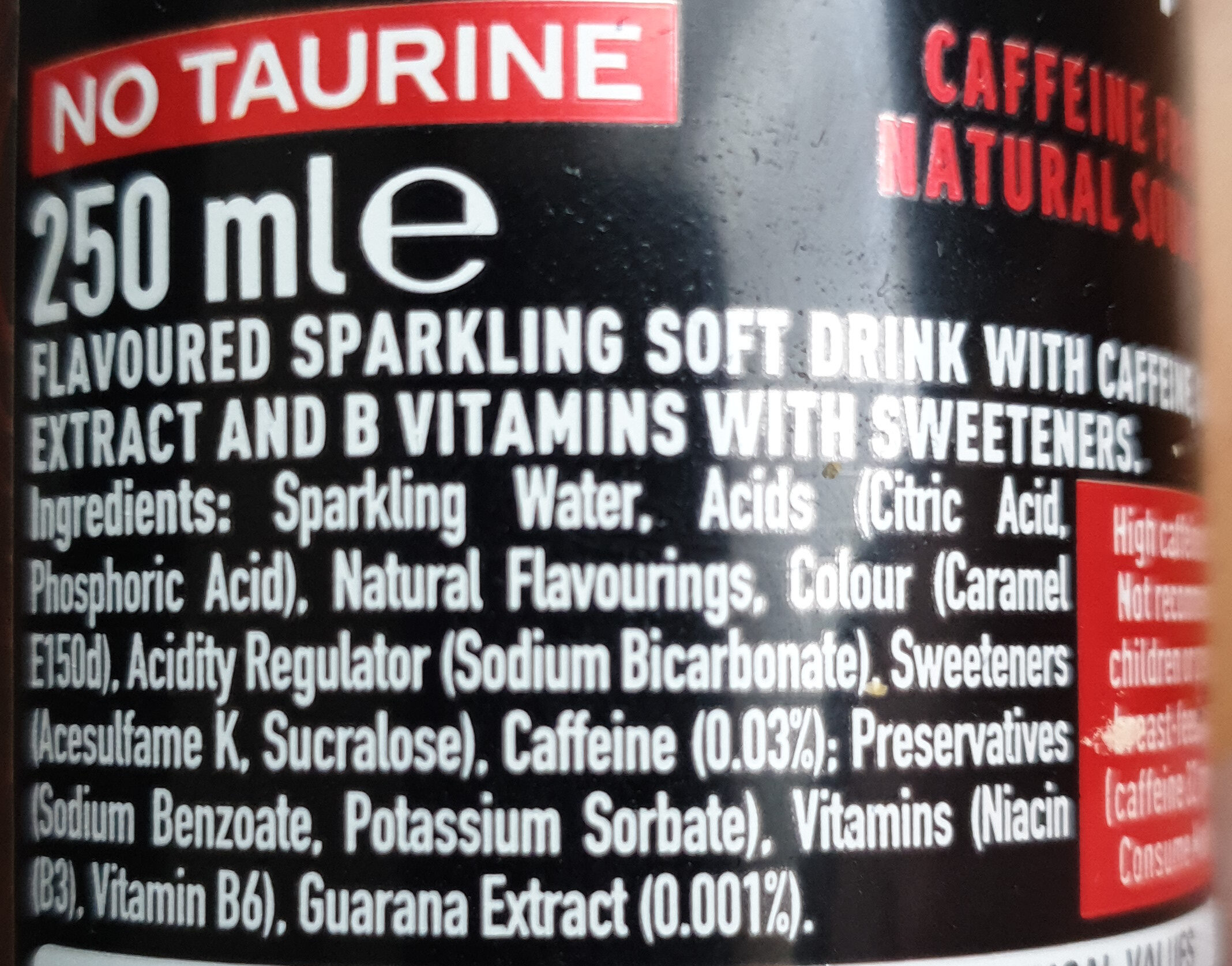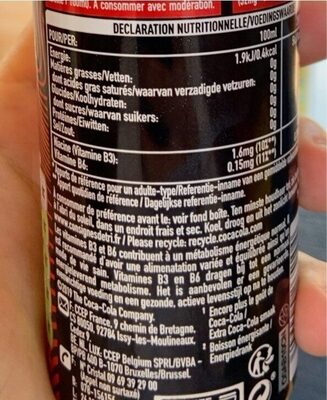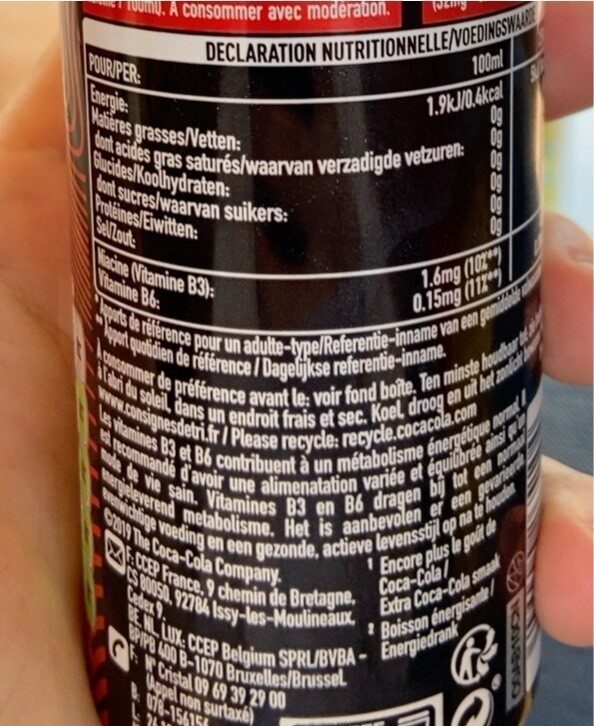Coca-Cola Energy No Sugar - 250ml
This product page is not complete. You can help to complete it by editing it and adding more data from the photos we have, or by taking more photos using the app for Android or iPhone/iPad. Thank you!
×
Barcode: 5449000265104 (EAN / EAN-13)
Allgemengen Numm:: Cola flavoured energy drink
Quantitéit: 250ml
Verpackungsart: en:Metal, en:Recyclable Metals, 41 ALU, en:Can, en:Drink can
Marken: Coca-cola
Kategorien: en:Beverages, en:Carbonated drinks, en:Artificially sweetened beverages, en:Sodas, en:Diet beverages, en:Non-alcoholic beverages, en:Colas, en:Diet sodas, en:Energy drinks, en:Diet cola soft drink
Geschäfter: Spar, Centra, carrefour.fr
Country: Belsch, Frankräich, Republik Irland, Lëtzebuerg (Land), Holland, Norwegen, Spuenien
Matching with your preferences
Environment
Verpackungsart
Transportation
Report a problem
Data sources
Product added on vun kiliweb
Last edit of product page on vun bertusdendroef.
Produkt Säit och geännert vun arthurcrbz, corentin-rng, driveoff, feat, inf, odinh, openfoodfacts-contributors, packbot, quechoisir, scanbot, scrypt, teolemon, yuka.R0lzeFBmUVRtZWxWb004WHBCK0YyTkJ1blpTR2ZFYUhHY1lVSWc9PQ, yuka.R0w0RFNMMWVqTXNBdXNZZTlDclRwK2xxM2NLWFJXbXhCdlE3SVE9PQ, yuka.Rm9FRkRvb0x1ZlV0c01FUXp3UDVvUHhLeDcvM1VrR3NCT2xCSVE9PQ, yuka.SEk5WkVvRUIvL291Z3NZa3BSZnYrTXBiNkorWGZrcXdkUGhPSVE9PQ, yuka.SEt4WVBva0JqS0lzeE1NOHB5TFMvZlJiekxLV0JVSzRDK1FESWc9PQ, yuka.UTRJTUhiMGZtOWtMbzhVTzRTN2MrTmtwbjVxa2VEdVpML1l0SVE9PQ, yuka.UXBrUkRwMERnZDhGbHNObit4VDVwbzF3eHNUd1drNldLcmN6SVE9PQ, yuka.UXJrcVBhZ3ZscVVMdy9Fdi9ETHBvZGxhNmNXM1VGN29kTXN3SUE9PQ, yuka.V0t3dFBJQUh0K2NWdTg5azdrL1RwK3RsK0w2V1ltcTVMZXdCSVE9PQ, yuka.V1pzQ0Nyb0ltcU12bHNFZzRoVFV4c0I3NXIzNEF6Mm9CZTRXSWc9PQ, yuka.V3I0dUZhczdvL1VGZ2NObDVnM3gwTjVSMzdENVlVT3lGTEUrSUE9PQ, yuka.VGJ3alRxNDlucWN5eThjYzVoN0svb3hQN29hSFFrT3JPY1U2SUE9PQ, yuka.VjUwcEZvYzQrTXNyaXZZZTREYk55TXBxN0pXNFFseUxFck05SVE9PQ, yuka.VnZwUkRid3pyOWNLa2NZVm9pUFkyZHRWL1kvemRHYVlHZElMSWc9PQ, yuka.VzY1Y1Racy9nL2NSd1BBeTF3bnhwNHA1MnJtV0FVZU9NOHNRSWc9PQ, yuka.WnIwK09ab3RodWRSbzlnWTgwN2JvdjVXM0wrVlhHcW5KY1VXSWc9PQ, yuka.YTUxYkU1UlIvZllwdnNZQTRoYlE2TWx1eHBhdFUwbW1GY2RMSVE9PQ, yuka.YWIxY0FxTUhvT1U2b2ZZeDRUblE1dDlLbVo2cUJqNnRlN0FoSVE9PQ, yuka.YmE5Y1NxOHRtdnhXeFBRUjB4WDQyZmxzM0xPa2JESzRKTTFOSVE9PQ, yuka.sY2b0xO6T85zoF3NwEKvlmBtaOX4kgrqbjnvgl2h2fqxCZDoUelcvdfVEao, yuka.sY2b0xO6T85zoF3NwEKvlmt5cYT0rGmeJj_goWKImdWnAbX2Z_Rt4K_RPag.









